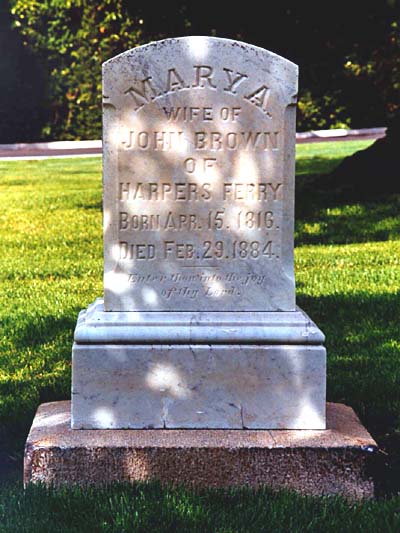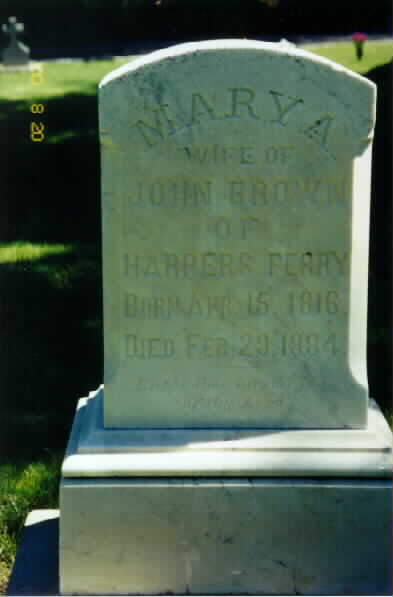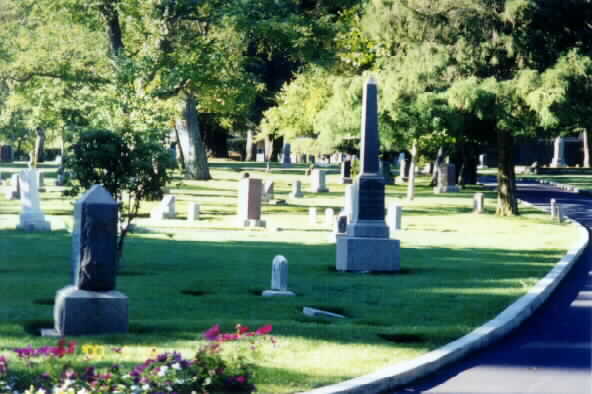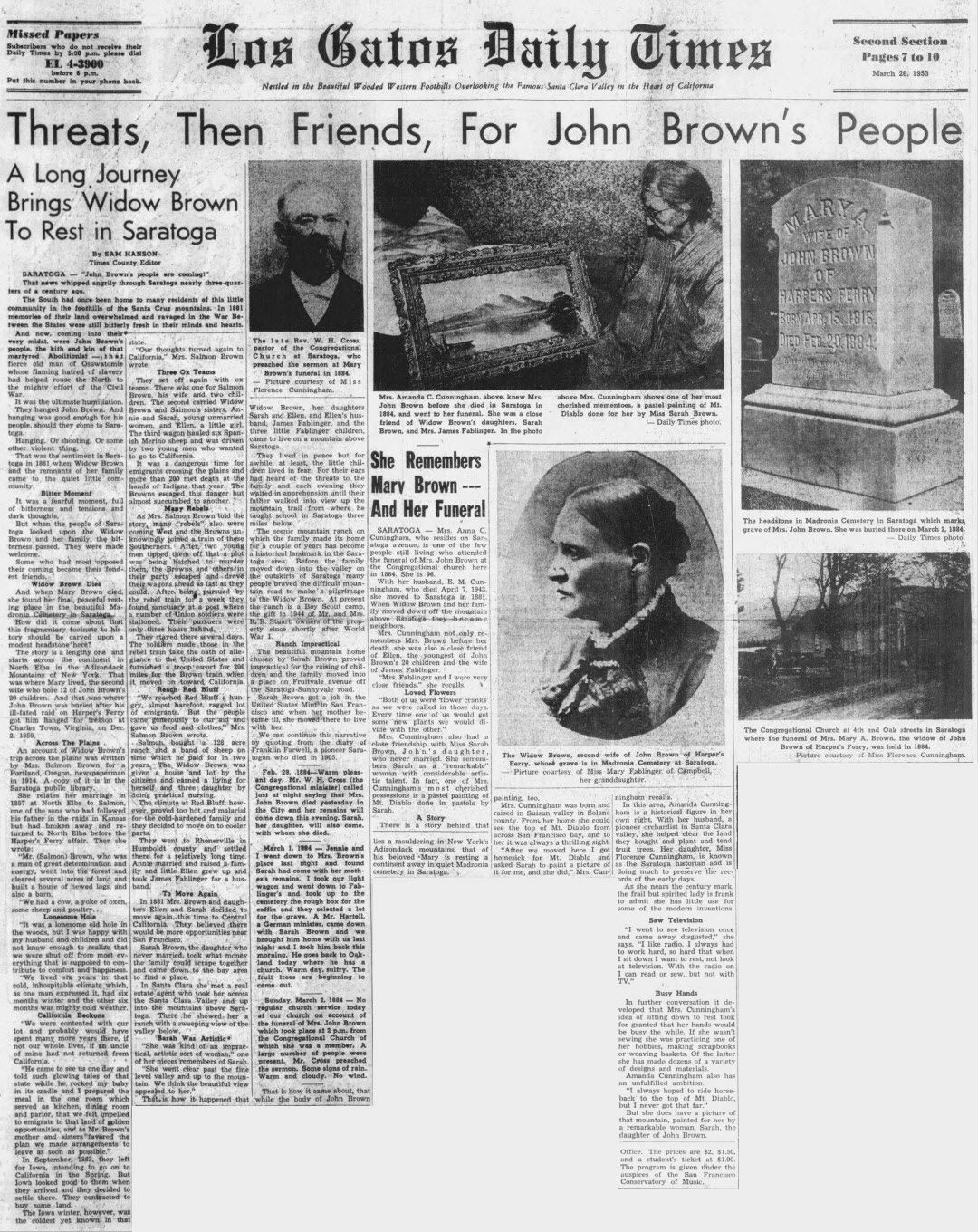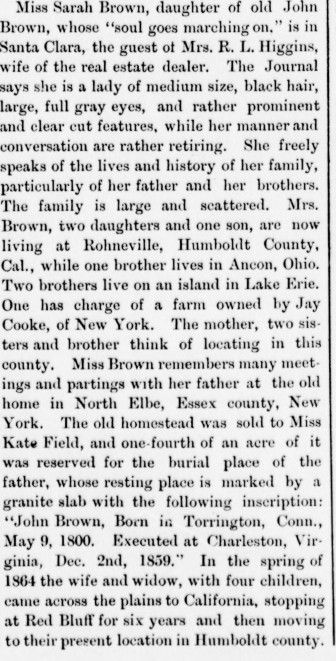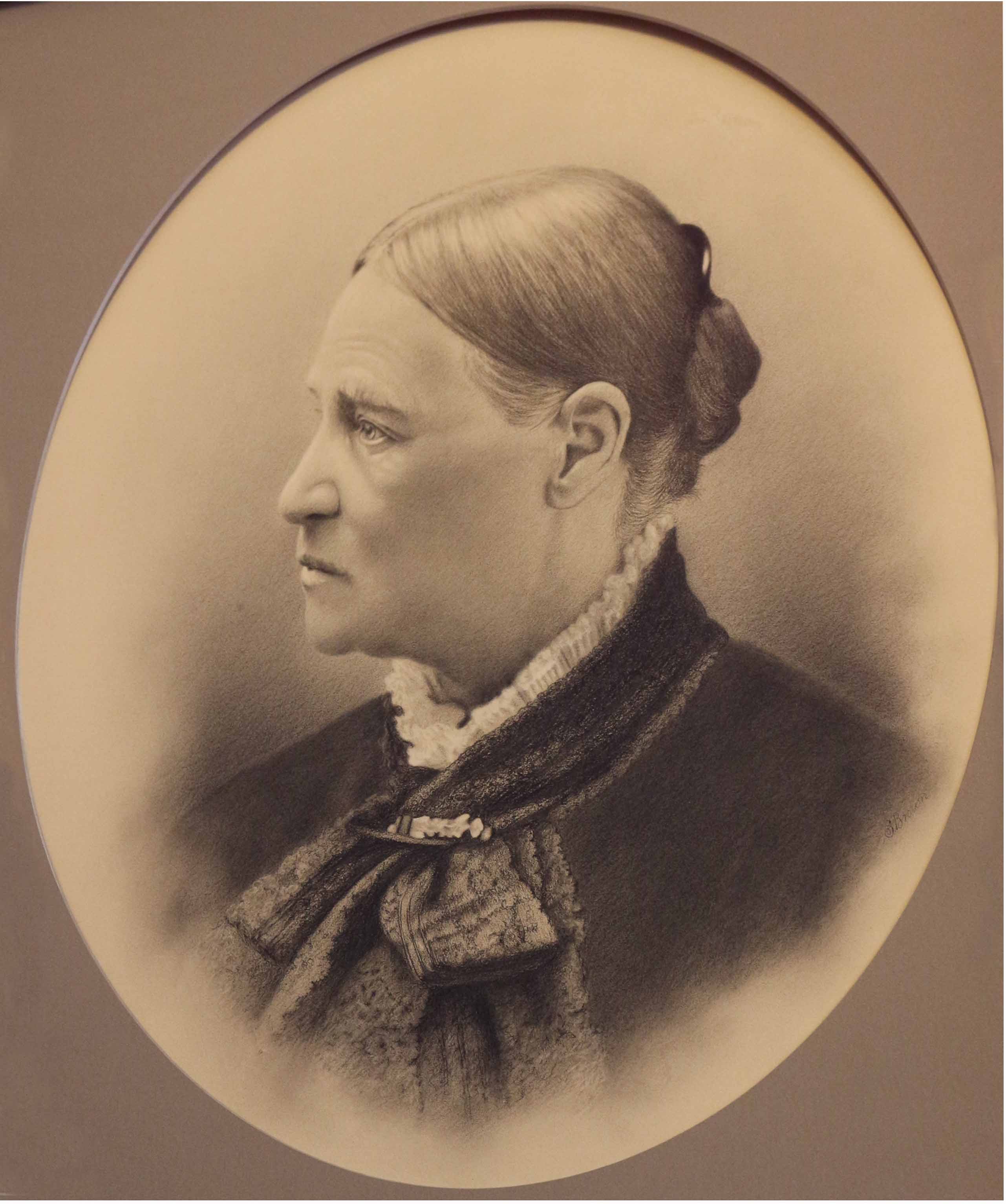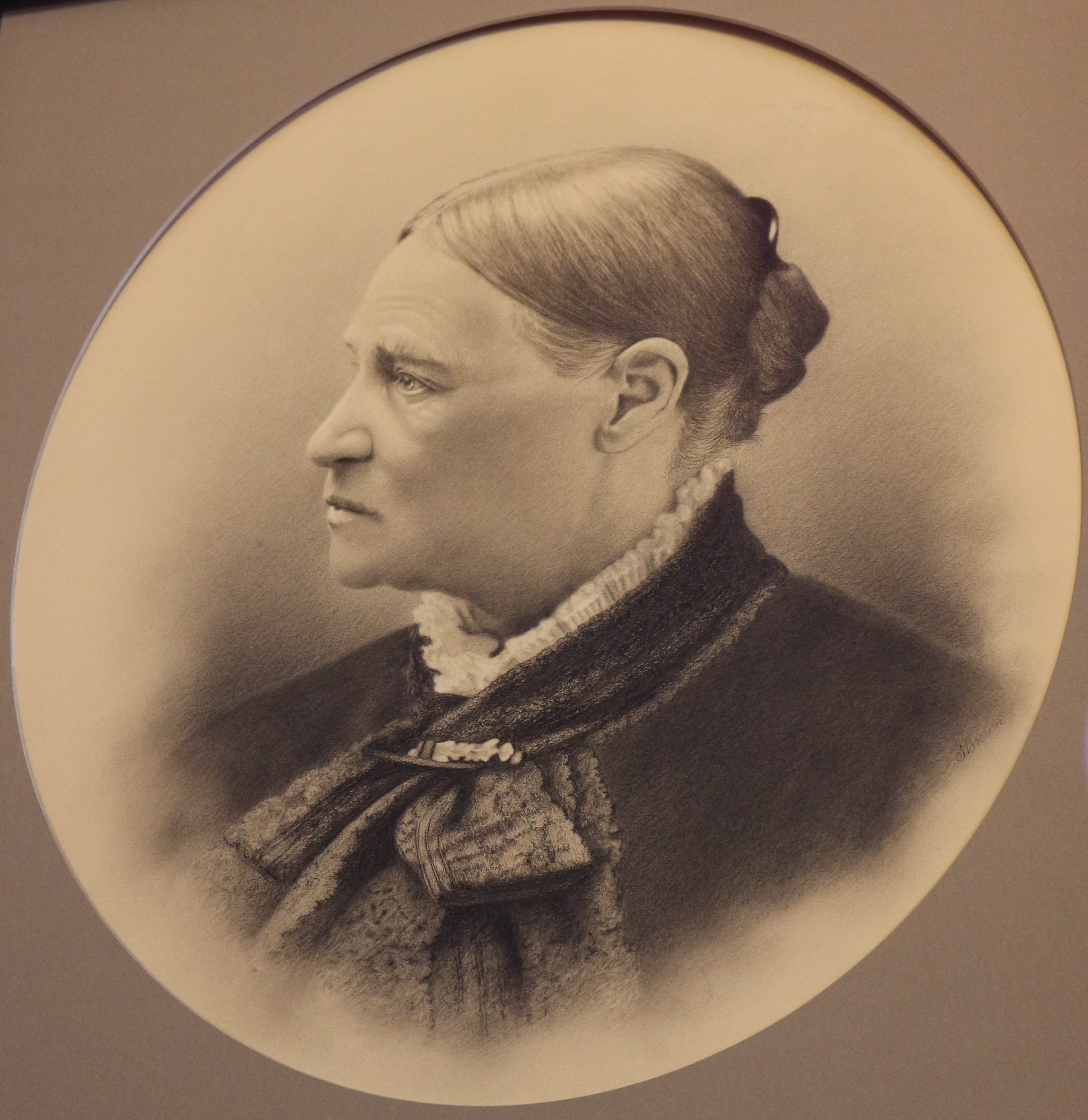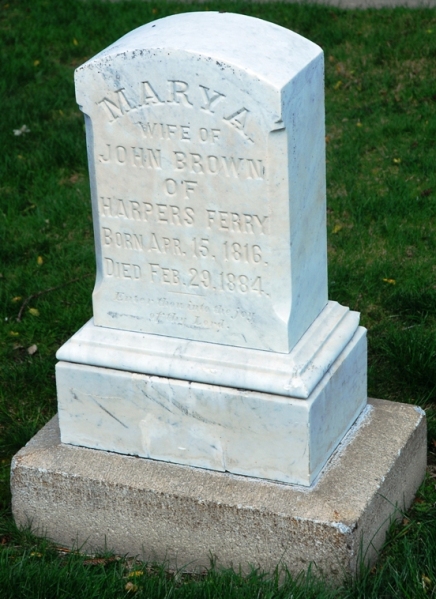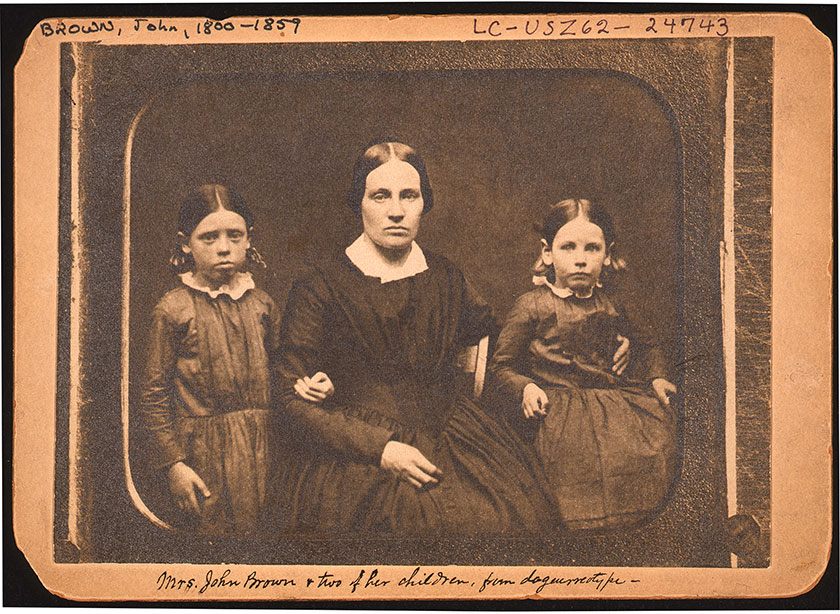She married the militant abolitionist in Pennsylvania in 1832, raising five children of his first wife and bearing thirteen of her own, of whom six survived to adulthood. Her sons Watson and Oliver died in John Brown's raid at Harpers Ferry in 1859. Mary bravely went to visit John on the day before his hanging on December 2. She brought his body home for burial in New York (now a state historic site), but Mary and her daughters emigrated to California in a wagon train in 1864.
She supported her husband's work to end slavery, and honored his memory until her death in 1884. Two daughters are buried next to her, "Daughters of John Brown."
Children of John Brown and Mary Ann Day Brown
Sarah Brown 1834-1843
Watson Brown 1835-1859
Salmon Brown 1836-1919
Charles Brown 1837-1843
Oliver Brown 1839-1859
Peter Brown 1840-1843
Austin Brown 1842-1843
Annie D Brown 1843-1926
Amelia Brown 1845-1846
Sarah Brown 1846-1916
Ellen Brown 1848-1849
Infant Brown 1852-1852
Ellen Brown 1854-1916
Bio changed and updated by Alice Keesey Mecoy 1/26/14
Additional Information
Brief biography of Mary A, Day wife of John Brown of Harpers Ferry"
Source: http://www.academia.edu/24400040/Brief_biography_of_Mary_Ann_Day_Brown
Blacksmith Charles Day (1777-1852) emigrated from central New York to Crawford County in western Pennsylvania, about 1825. Daughter Mary Ann Day was raised by his second wife Mary Ann Little (1787-1882). Her mother, Mary Eleanor Gould, born 1780 passed away in 1819, leaving young Mary and two older brothers (Horace Day (1805-1863) and John C. (1815-1880). Older half-sister Martha Day (1802-1862) married Thomas Delameter in upstate New York; the family emigrated together. John Brown and his first wife Dianthe Lusk Brown emigrated from Hudson, Ohio in the same period (1826).
Brown built a tannery which was innovative in methods. He organized a school with the Delameters; their oldest sons were contemporaries and lifelong friends. Brown was appointed postmaster of Richmond Township by President John Quincy Adams. The tannery is owned by the John Brown Heritage Association of Meadville, named to the National Register of Historic Places in 1978. Dianthe died with complications of childbirth in 1832, leaving five children between the ages of three and twelve.
Mary was asked by the widowed John Brown to be his second wife while she assisted the household following the death of Dianthe. They married in 1833, when she was seventeen and John Brown was thirty-three. Mary bore thirteen children in the next twenty years, only six of whom survived to adulthood. Four were taken in a cholera epidemic in Franklin, Ohio, where Brown had moved in 1835 to begin new businesses. In 1846 John Brown and Col. Simon Perkins, son of the founder of Akron, Ohio began a wool-manufacture which brought him and his young family to Springfield, Massachusetts.
Frederick Douglass met the Browns in Springfield in 1848 and wrote movingly of Mary's participation in the Underground Railroad for people seeking freedom. In 1849 an agreement was made with Gerrit Smith, an abolitionist in New York, for John and Mary to live in a cooperative African American community in the Adirondack Mountains.
John Brown joined his older sons and their families who emigrated to Kansas to lead armed defense of freestate settlers from 1855 to 1858; Mary and the children remained in the Adirondack community of North Elba. When her husband was hanged in Virginia on December 2, 1859, Mary journeyed with abolitionists to visit him in jail and returned John Brown's body to their New York farm, which is now a state memorial park.
The story of John Brown embracing an enslaved mother and child on his way to execution is Mary's deliberate contribution to the meaning of the sacrifice of her family. She was entrusted with the letter expressing his last wish that slaves be his attendants rather than southern ministers. Mary was the only visitor allowed to see Brown on the day before his hanging. She read the contents to the New York press, meeting them in interview alone outside the jail.
Before the letter was delivered to Mrs. George Stearns in Massachusetts the widow Mary Brown hand-copied it for her husband's legacy , which was recognized by Boyd Stutler as her handwriting.
She advised artist Louis Ransom who painted the scene envisioned by the poets and journalists in 1860 and actively participated with biographer James Redpath. Mary Brown, three daughters, and only surviving son Salmon came to California in a yearlong journey that ended in Tehama County in 1864. She is remembered as "a ministering angel and wagon train leader of determination and spirit.
There was real danger to Mary and her family from Confederates as they crossed the country. Protection came from other emigrants, including an African American group who joined them for that purpose, dashing headlong for a full week to reach a U. S. military fort. Daughters Annie and Sarah taught at "Colored" schools in and near Red Bluff, publicly supporting an end to racial segregation, as did their mother. Sarah mentored the first African American teacher to become certificated in California, Clara Logan Frazier.
People in the community raised $450 to build Mary a home in January 1866 which still stands today and is recognized for her residence. When the Colored School was burned by arson in 1869, Mary and her daughters moved to Rohnerville, Humboldt County, where Salmon and his family were raising sheep. Annie married Samuel Adams and remained; Ellen married teacher James Fablinger from Illinois in 1876. Finding employment at the Oak Street School, James brought Mary Brown, Sarah, his wife and three very young children to Saratoga in 1881. They purchased a cabin on top of the mountain from Rufus L. Higgins of Santa Clara, who led a contribution campaign for the family of abolitionist John Brown.
Finding the commute too steep the family rented the McGrew House on Saratoga Avenue. In 1882 Mary learned that her son Watson who died at Harpers Ferry, his remains liberated by the Union Army in the Civil War, was to be ceremoniously interred with his father at North Elba. Leaving Sarah at her new job at the U. S. Mint in San Francisco, Mary journeyed alone to Meadville to visit relatives, then to Boston and the Adirondack farm for Watson's burial. On her return she visited Kansas for the first time, speaking about her husband and the end of slavery. She donated the gold Medal of Honor from France struck for John Brown to the Kansas Historical Society.
Her August -December 1882 journey went to Humboldt County to visit Annie and the grandchildren, returning to Saratoga where she lived but another year. She sold the mountain property to her daughters for $1 in 1883, passing away from cancer on February 29, 1884. Mary Brown and her daughter Sarah are known for missionary activities with the Saratoga Congregational Church and forthright opposition to anti-Asian laws and discrimination. Sarah requested that a mission established in China following the exclusion and expulsion of pioneer Chinese laborers in the late 1800's be named for her mother.
As Japanese family immigration began in the early 1900's Sarah learned the language from local residents in order to teach English within the auspices of the Congregational Church of Saratoga and the American Missionary Association. Community friendships of Mary and her namesake Fablinger granddaughter with Amanda and Florence Cunningham have the lasting result of permanent stewardship at the Saratoga History Museum. The friendship of Sarah Brown with Lucy Higgins of Santa Clara, both ardent suffragists, is a legacy remembered and passed on at The Bancroft Library, The University of California, Berkeley, in the present day.
Contributor: Dave Peck (46966140) • [email protected]
She married the militant abolitionist in Pennsylvania in 1832, raising five children of his first wife and bearing thirteen of her own, of whom six survived to adulthood. Her sons Watson and Oliver died in John Brown's raid at Harpers Ferry in 1859. Mary bravely went to visit John on the day before his hanging on December 2. She brought his body home for burial in New York (now a state historic site), but Mary and her daughters emigrated to California in a wagon train in 1864.
She supported her husband's work to end slavery, and honored his memory until her death in 1884. Two daughters are buried next to her, "Daughters of John Brown."
Children of John Brown and Mary Ann Day Brown
Sarah Brown 1834-1843
Watson Brown 1835-1859
Salmon Brown 1836-1919
Charles Brown 1837-1843
Oliver Brown 1839-1859
Peter Brown 1840-1843
Austin Brown 1842-1843
Annie D Brown 1843-1926
Amelia Brown 1845-1846
Sarah Brown 1846-1916
Ellen Brown 1848-1849
Infant Brown 1852-1852
Ellen Brown 1854-1916
Bio changed and updated by Alice Keesey Mecoy 1/26/14
Additional Information
Brief biography of Mary A, Day wife of John Brown of Harpers Ferry"
Source: http://www.academia.edu/24400040/Brief_biography_of_Mary_Ann_Day_Brown
Blacksmith Charles Day (1777-1852) emigrated from central New York to Crawford County in western Pennsylvania, about 1825. Daughter Mary Ann Day was raised by his second wife Mary Ann Little (1787-1882). Her mother, Mary Eleanor Gould, born 1780 passed away in 1819, leaving young Mary and two older brothers (Horace Day (1805-1863) and John C. (1815-1880). Older half-sister Martha Day (1802-1862) married Thomas Delameter in upstate New York; the family emigrated together. John Brown and his first wife Dianthe Lusk Brown emigrated from Hudson, Ohio in the same period (1826).
Brown built a tannery which was innovative in methods. He organized a school with the Delameters; their oldest sons were contemporaries and lifelong friends. Brown was appointed postmaster of Richmond Township by President John Quincy Adams. The tannery is owned by the John Brown Heritage Association of Meadville, named to the National Register of Historic Places in 1978. Dianthe died with complications of childbirth in 1832, leaving five children between the ages of three and twelve.
Mary was asked by the widowed John Brown to be his second wife while she assisted the household following the death of Dianthe. They married in 1833, when she was seventeen and John Brown was thirty-three. Mary bore thirteen children in the next twenty years, only six of whom survived to adulthood. Four were taken in a cholera epidemic in Franklin, Ohio, where Brown had moved in 1835 to begin new businesses. In 1846 John Brown and Col. Simon Perkins, son of the founder of Akron, Ohio began a wool-manufacture which brought him and his young family to Springfield, Massachusetts.
Frederick Douglass met the Browns in Springfield in 1848 and wrote movingly of Mary's participation in the Underground Railroad for people seeking freedom. In 1849 an agreement was made with Gerrit Smith, an abolitionist in New York, for John and Mary to live in a cooperative African American community in the Adirondack Mountains.
John Brown joined his older sons and their families who emigrated to Kansas to lead armed defense of freestate settlers from 1855 to 1858; Mary and the children remained in the Adirondack community of North Elba. When her husband was hanged in Virginia on December 2, 1859, Mary journeyed with abolitionists to visit him in jail and returned John Brown's body to their New York farm, which is now a state memorial park.
The story of John Brown embracing an enslaved mother and child on his way to execution is Mary's deliberate contribution to the meaning of the sacrifice of her family. She was entrusted with the letter expressing his last wish that slaves be his attendants rather than southern ministers. Mary was the only visitor allowed to see Brown on the day before his hanging. She read the contents to the New York press, meeting them in interview alone outside the jail.
Before the letter was delivered to Mrs. George Stearns in Massachusetts the widow Mary Brown hand-copied it for her husband's legacy , which was recognized by Boyd Stutler as her handwriting.
She advised artist Louis Ransom who painted the scene envisioned by the poets and journalists in 1860 and actively participated with biographer James Redpath. Mary Brown, three daughters, and only surviving son Salmon came to California in a yearlong journey that ended in Tehama County in 1864. She is remembered as "a ministering angel and wagon train leader of determination and spirit.
There was real danger to Mary and her family from Confederates as they crossed the country. Protection came from other emigrants, including an African American group who joined them for that purpose, dashing headlong for a full week to reach a U. S. military fort. Daughters Annie and Sarah taught at "Colored" schools in and near Red Bluff, publicly supporting an end to racial segregation, as did their mother. Sarah mentored the first African American teacher to become certificated in California, Clara Logan Frazier.
People in the community raised $450 to build Mary a home in January 1866 which still stands today and is recognized for her residence. When the Colored School was burned by arson in 1869, Mary and her daughters moved to Rohnerville, Humboldt County, where Salmon and his family were raising sheep. Annie married Samuel Adams and remained; Ellen married teacher James Fablinger from Illinois in 1876. Finding employment at the Oak Street School, James brought Mary Brown, Sarah, his wife and three very young children to Saratoga in 1881. They purchased a cabin on top of the mountain from Rufus L. Higgins of Santa Clara, who led a contribution campaign for the family of abolitionist John Brown.
Finding the commute too steep the family rented the McGrew House on Saratoga Avenue. In 1882 Mary learned that her son Watson who died at Harpers Ferry, his remains liberated by the Union Army in the Civil War, was to be ceremoniously interred with his father at North Elba. Leaving Sarah at her new job at the U. S. Mint in San Francisco, Mary journeyed alone to Meadville to visit relatives, then to Boston and the Adirondack farm for Watson's burial. On her return she visited Kansas for the first time, speaking about her husband and the end of slavery. She donated the gold Medal of Honor from France struck for John Brown to the Kansas Historical Society.
Her August -December 1882 journey went to Humboldt County to visit Annie and the grandchildren, returning to Saratoga where she lived but another year. She sold the mountain property to her daughters for $1 in 1883, passing away from cancer on February 29, 1884. Mary Brown and her daughter Sarah are known for missionary activities with the Saratoga Congregational Church and forthright opposition to anti-Asian laws and discrimination. Sarah requested that a mission established in China following the exclusion and expulsion of pioneer Chinese laborers in the late 1800's be named for her mother.
As Japanese family immigration began in the early 1900's Sarah learned the language from local residents in order to teach English within the auspices of the Congregational Church of Saratoga and the American Missionary Association. Community friendships of Mary and her namesake Fablinger granddaughter with Amanda and Florence Cunningham have the lasting result of permanent stewardship at the Saratoga History Museum. The friendship of Sarah Brown with Lucy Higgins of Santa Clara, both ardent suffragists, is a legacy remembered and passed on at The Bancroft Library, The University of California, Berkeley, in the present day.
Contributor: Dave Peck (46966140) • [email protected]
Bio by: Janice Buchanan
Inscription
Mary A., wife of John Brown of Harpers Ferry.
Born Apr 15 1816
Died Feb 29 1884
Enter thou into the joy of the Lord





















